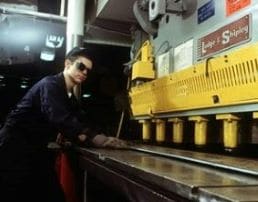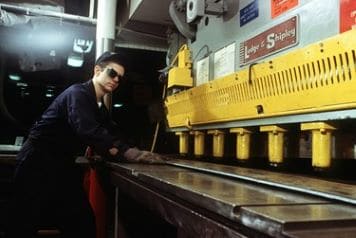Important Things To Consider Before Buying A Sheet Metal Shear Machine For Your Business

Buying a machine designed to shear and shape sheet metal can be an important investment in your business, but since these machines come at a price, it’s important to compare your options. The type of machine you need depends on what you’ll need it for, as most are rated by their ability to cut through different metal thicknesses, the quality of the materials, and suitability.
What is Metal Shearing?
Metal shearing is a catch-all term used in the metal fabrication process that includes various equipment. Shearing machines trim unwanted material in a straight line.
Fabrication equipment is all the equipment used in the sheet metal shop; some examples include manual, air-operated, electric, hydraulic, and mechanical sheers. It also includes forming rolls or the break (bends sheet metal). Anyone interested in buying metal shear for sale must know how metal shearing works, or they risk losing thousands of dollars.
How Does Metal Shearing Work?
Metal shears are far more technically advanced than we give them credit for. With a series of pressurized clamps, a lower and top blade will cut sheet metal with a great deal of force without heat and doesn’t produce waste like bits of metal or chips. The upper or top blade is placed at an angle to reduce the force applied just enough for the metal to not split in the wrong direction.
Metal shearing blades come in different degrees of resistance, shock absorption, and hardness.
5 Factors to Consider Before Buying a Sheet Metal Shear
What Metal Do You Plan to Shear?
Sheet metal comes in different shapes and sizes, but what’s more important to consider is the thickness, type, and consistency rather than the length and width. You can always cut down sheet metal into smaller parts. If you want to reduce the overall time the sheet metal shearing machine takes to cut, a larger machine is best, but not necessary.
Light aluminum or gage metal will work fine with an electrical or air-operated shear, but any metal thicker than ¾ may need a higher quality mechanical shear with good shock absorption.
All metals shear differently, regardless if they’re flat or thick. Consider the structure of the metal that you wish to cut as well, as perforated metal won’t shear like treadplates.
What Quality of Parts Do You Need?
Large HVAC companies can’t afford to buy a cheap machine because it’ll break quickly and leave you without parts for at least a day. However, if you’re an HVAC company that only repairs sheet metal, not install, you could get away with a less sophisticated machine.
More expensive, quality machines will come with many options like stackers or conveyors, front gauging options, and high-speed hydraulics.
What Kind of Shearing System Suits Your Business?
There are 5 main shearing systems available for purchase: manual, air-operated, eclectic, hydraulic, and mechanical. All of these systems have unique positives and negatives, while others won’t work with your desired material at all.
- Mechanical: Longest lasting, best production rated, and has the highest absorption. Mechanical shears are quiet, fast, and simple to use. They’ll hold up against extended wear and tear and will likely keep running for decades.
- Hydraulic: Hydraulic presses or shears use a shearing blade with 14 gauge shears and thick hydraulics. They are less expensive than mechanical shears but lack speed.
- Electric: Electric equipment drives the shears through electricity, inertia, and force. Can work down 12-14 gauge steels and are smooth, fast, and quiet.
- Air Operated: Uses manual shears and adds a pneumatic element that reduces operator fatigue—mainly used on 18 gauge or thinner.
- Manual: The oldest type of shearing system, manual shears also work with 18 gauge metal or thinner and is a light machine commonly found in most HVAC companies.
Keep in mind that manual shears break down a lot faster than electric, hydraulic and mechanical shears because they are more susceptible to human operating errors.
Should I Buy a Swing Beam or Guillotine?
Once you’ve chosen a shearing system, you can then pick the design that’s best suited for the metal you’re using. A guillotine blade drives into the metal downward, is robust, and expensive. The swing beam pivots the upper blade before forcing it downwards and uses hydraulic components due to the leverage in its design.
Should I Buy a Fixed or Adjustable Rake Angle?
The rake angle refers to the angle of the upper blade. A lower angle will produce a higher quality shearing edge and requires more force to shear. The best rake angle is at a zero-degree angle, but that would make the shear machine too expensive. Fixed rake angles stay put during shearing, while adjustable rakes use smaller shears and prolong the manufacturing process.




